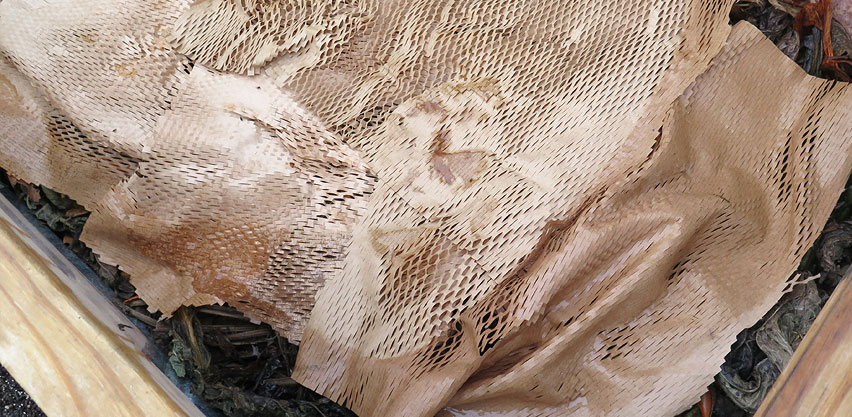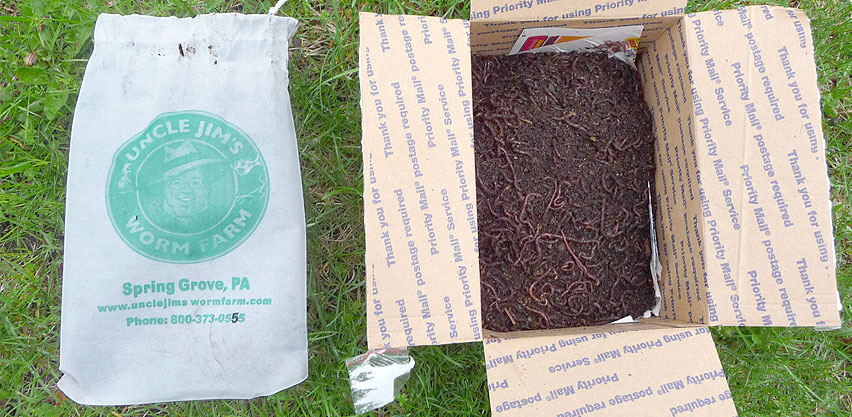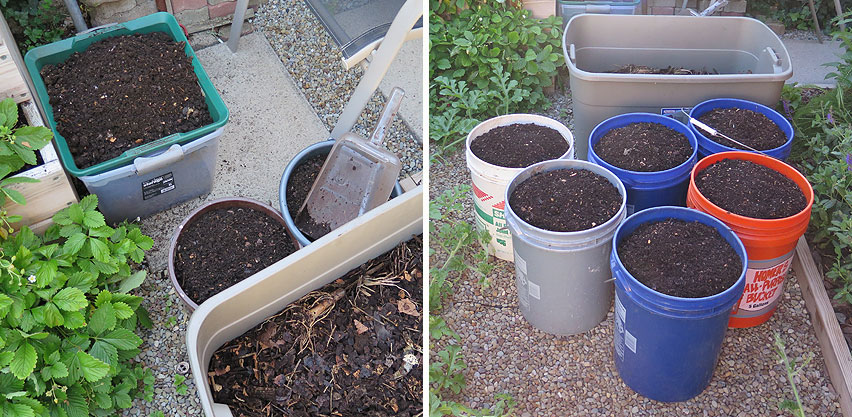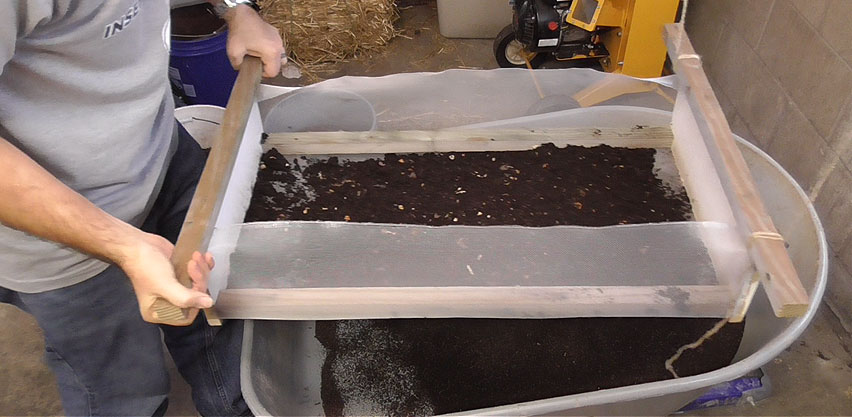Vermicomposting:
How to Make a Worm Bin!
Many composting tutorials portray an overcomplicated process requiring a perfect balance of "greens" and "browns." You need to get the moisture levels just right. In the natural world around us, all of our resources are scrubbed, broken down and reused. Bacteria, fungi and invertebrates do the dirty work. They don't need us. Not one bit. In fact, sometimes we pesky humans just get in the way! Depending on how you do it, vermicomposting can be an effortless process.
Generating worm castings is a highly sustainable way of generating your own natural organic nutrients. The castings work great as a fertilizer, especially in container gardening. In fact, this past Winter, I did some tests using worm castings to make a seed starting mix. The results where impressive!
- How to Raise Worms Outdoors in Worm Bins:
- Composting Indoors with Worms
- Can Red Worms Survive Outdoors in the Winter?
- How to Build DIY Worm Composting Bins
- Worm Compost Sifter for Castings
Video: Compost Worm Bins:
How to Sift Worm Castings
My outdoor worm box planter performs very well and requires very little space!
Composting Indoors with Worms
Vermicomposting is an excellent way to compost indoors using worms such as red wigglers. It's easy to create a DIY indoor worms bin from containers like plastic totes. This requires virtually NO space and is a perfect fit for people who have very little space, such as apartment dwellers.
When using an indoor worm bin, the container needs to be covered with a lid. But it should also have small holes at the top allowing the system to breathe. Plan on feeding your worms a several times per week. Soft vegetable and fruit scraps are ideal. Cut up any dense woody stems into small pieces.

In addition to autumn leaves, shredded brown packing paper is a free worm bedding material!
The worms will need some sort of bedding material. This is a carbon rich organic material that retains moisture. Peat moss is a common bedding that worms tend to thrive in. Finely shredded pieces of cardboard can also serve the function of bedding. Premoisten the cardboard before layering it in as bedding. When adding fresh food scraps, just bury them under the bedding in various pockets throughout the bin.
Can Red Worms Survive Outdoors in the Winter?
Worm bins work great indoors. Whether it's an apartment, a basement or a garage, you can use worms to process food scraps year round. What about outdoors though? Many retail worm bin kits are designed for outdoor use. But gardeners soon realize that these systems will freeze solid in temperate areas once the freezing weather sets in. Is there any way to protect your worms in their outdoor worm bins during cold Winters? Will the worms survive or will they all freeze to death?

I've been able to sustain these composting red worm in my outdoor worm bin despite freezing temps!
RED WIGGLERS CAN SURVIVE! I purchased a small box of red wiggler composting worms in April of 2013. I set up my outdoor worm bin. I've kept them outside and ever since, they survived every single Winter! I'm in Zone 6 and our Winters can get fairly cold. But by setting things up correctly my red worms have been protected just enough so they can survive, pumping out gallons and gallons of rich worm casting each season.
How to Build DIY Worm Composting Bins
There are many ways to build at outdoor DIY worm composting bin. If you want your red worms to survive a frigid Winter, then there are two crucial elements to success: Size & Location. You need to construct a worm bin that is relatively large. It should cover a minimum area of 8 to 9 square feet. So a 3' x 3' or 2' x 4' bin size should considered the minimum for outdoor worm composting.
Additionally, you absolutely need to build it on the ground. If you have a raised bin that is on legs, then you can expect it to freeze solid during a cold Winter. But a bin that rests on the ground can hold in the heat from the earth below and your worms will fair much better. You can also load the bin up with a couple feet of autumn leaves to create a nice layer insulation.

My 1st worm bin lasted 8 years & was made with treated decking boards. This new one uses galvanized metal sides.
WORM BIN MATERIALs: You can use just about any construction materials that you want for an outdoor worm bin. Bricks or concrete blocks work just fine. The bin is essentially a really deep raised bed. Some gardeners will use cedar boards for their beds, which is a great wood to use, but it can be more costly. Instead, I've used treated lumber. Online tutorials might warn against using treated lumber. Here in the US though, consumer grade treated wood does not contain arsenic or chromium anymore. So there's no legitimate reason to avoid treated. Truth be told, lumber prices have sky rocketed though. So you might find it more cost effective to use galvanized metal sheets for the side panels of your bin.
FILLING AN OUTDOOR WORM BIN: Filling an outdoor worm bin is a different process than a small indoor one. These all-season bins work best when they're harvested annually. In the Spring I'll pull out all materials. The upper layers of organic matter that are not totally broken down, get thrown on a tarp. The lower layers contain the rich worm castings / vermicompost. I'll harvest that finished compost / castings. I separate out the worms from the castings. Then I place all of the remaining scraps and worms back into the bin.
For the next year I simply add layers of organic matter when available. Vegetable kitchen scraps work well. I'll add disease-free garden plants from the end of the season. Autumn leaves are excellent additions and the tops of my comfrey plants. You can add some weeds, but try not to throw in seed heads. From time to time I might drop in a layer of clean cardboard. Just keep piling this on until you harvest again in the Spring.

On a small scale, you can use a sifting tray to screen out large pieces from your vermicompost.
Worm Compost Sifter for Castings
Once you've pulled your vermicompost from your worm bin, you have a rich fertile "black gold" to use in your garden. Technically, you don't need to do anything to it. If you aren't particular you could just mix the vermicompost right into your beds. I've used it as a compost in my "Mel's Mix" to fill small raised beds. You can mix it at a 1:1:1 ratio with peat moss and vermiculite to make a highly fertile raised bed mix that will grow lush vigorous vegetables.
Or if you prefer, you could sift the vermicompost to extract the very fine worm castings. These can be used in things like potting mixes as a renewable fertilizer. Amazon sells small trays which work as a garden sieve for sifting compost or soil. Or if you prefer, you could even use a mesh screen from a screen door. One year, I decided to sift a large volume of vermicompost. I rigged up a sifting box which allowed me to filter out 16 gallons of castings!

This is a super simple system that quickly sifted out lots of super fine worm castings!.

![GARDENERS: Who else would pay money for poop? [Gardening T-Shirt Design]](images/GARDENERS--Who-else-would-pay-money-for-poop_Gardening-Tshirt-th.jpg)
![ORGANIC Garden Produce [Gardening T-Shirt Design] ORGANIC Garden Produce [Gardening T-Shirt Design]](images/ORGANIC-Garden-Produce_Gardening-Tshirt-Spreadshirt.jpg)
![Friends Don't Let Friends Throw Out Leaves [Gardening T-Shirt Design]](images/Friends-Dont-Let-Friends-Throw-Out-Leaves_Gardening-Tshirt-th.jpg)